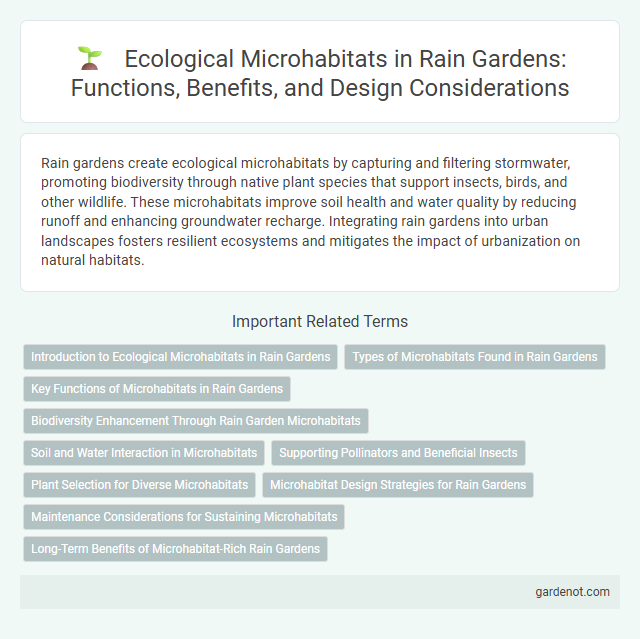Rain gardens create ecological microhabitats by capturing and filtering stormwater, promoting biodiversity through native plant species that support insects, birds, and other wildlife. These microhabitats improve soil health and water quality by reducing runoff and enhancing groundwater recharge. Integrating rain gardens into urban landscapes fosters resilient ecosystems and mitigates the impact of urbanization on natural habitats.
Introduction to Ecological Microhabitats in Rain Gardens
Ecological microhabitats in rain gardens provide specialized environments that support diverse plant and animal species, enhancing urban biodiversity. These microhabitats are created through variations in soil moisture, plant structure, and sunlight exposure, offering niches for insects, amphibians, and birds. Effective design of rain gardens maximizes these microhabitats, promoting ecological balance and stormwater management.
Types of Microhabitats Found in Rain Gardens
Rain gardens create diverse ecological microhabitats such as saturated zones, transition zones, and upland areas that support a variety of plant and animal species. Saturated zones mimic wetlands, harboring hydrophytic plants and amphibians, while transition zones offer moderately moist conditions ideal for shrubs and insects. Upland areas provide drier environments suitable for grasses and pollinators, promoting biodiversity within urban stormwater management systems.
Key Functions of Microhabitats in Rain Gardens
Microhabitats in rain gardens play a crucial role in supporting biodiversity by providing specialized niches for various plant and animal species. They enhance water filtration and nutrient cycling, improving the overall ecological health of urban environments. These microhabitats also contribute to soil stabilization and create microclimates that help regulate temperature and moisture levels.
Biodiversity Enhancement Through Rain Garden Microhabitats
Rain garden microhabitats create diverse ecological niches by supporting native plants, insects, amphibians, and microorganisms, which enhances local biodiversity. Their design promotes soil moisture variability and nutrient cycling, fostering a rich environment for pollinators and aquatic species. By mimicking natural wetland conditions, rain gardens serve as critical refuges for species in urban landscapes, boosting ecosystem resilience and connectivity.
Soil and Water Interaction in Microhabitats
Rain gardens create ecological microhabitats that enhance soil and water interaction by promoting infiltration and filtration of stormwater. The diverse soil composition and vegetation in these areas improve nutrient cycling, support microbial activity, and maintain moisture balance. This interaction reduces runoff, mitigates erosion, and replenishes groundwater, fostering a sustainable urban ecosystem.
Supporting Pollinators and Beneficial Insects
Rain gardens create ecological microhabitats by providing diverse native plants that attract and support pollinators such as bees, butterflies, and hummingbirds. These gardens offer essential resources like nectar, pollen, and shelter, promoting the survival of beneficial insects that enhance local biodiversity. Incorporating rain gardens into urban and suburban landscapes improves pollinator populations critical for ecosystem health and agricultural productivity.
Plant Selection for Diverse Microhabitats
Selecting native plants with varied root depths and water tolerances enhances the ecological complexity of rain garden microhabitats. Incorporating species such as Carex spp., Juncus effusus, and Lobelia cardinalis supports diverse soil moisture conditions and attracts pollinators. This strategic plant selection promotes nutrient cycling, improves water filtration, and sustains local biodiversity.
Microhabitat Design Strategies for Rain Gardens
Effective microhabitat design strategies for rain gardens integrate native plant species selection, soil amendment, and layered vegetation structures to enhance biodiversity and water filtration. Strategic placement of rocks and logs creates shelter and breeding grounds for invertebrates and amphibians, supporting ecological functions within urban landscapes. Incorporating varied moisture zones within the garden promotes diverse microhabitats that sustain pollinators, birds, and beneficial microorganisms.
Maintenance Considerations for Sustaining Microhabitats
Rain gardens require regular maintenance such as seasonal weeding, mulching, and monitoring water flow to sustain their ecological microhabitats. Maintaining diverse native plant species promotes habitat stability and supports local wildlife by providing food and shelter. Proper debris removal and controlled irrigation prevent invasive species and waterlogging, ensuring long-term microhabitat health.
Long-Term Benefits of Microhabitat-Rich Rain Gardens
Rain gardens that incorporate diverse ecological microhabitats support long-term benefits such as enhanced biodiversity by providing shelter and breeding grounds for pollinators and native species. These microhabitats improve soil health and water quality through natural filtration processes, reducing urban runoff and mitigating flood risks. Over time, microhabitat-rich rain gardens create resilient ecosystems that contribute to climate regulation and strengthen urban green infrastructure.
Ecological microhabitat Infographic

 gardenot.com
gardenot.com